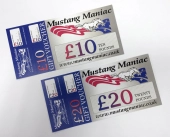Two weeks ago Mustang and Chrysler fans around the world mourned the loss of a huge figure in the automotive industry.
Lido Anthony Iacocca better known as ‘Lee’ Iacocca was born on 15 October 1924 and died 2 July 2019, he was 94.
Vice President of Ford Motor Company and he was the man responsible for bringing us the Ford Mustang in 1964. This famous picture below of Lee giving his introduction speech for the Mustang at the World Trade Fair Sunday 13th April 1964. That speech ended with the those famous five words ‘Ladies & gentlemen – the Mustang’. At that moment history was made with the car going on to sell an unprecedented 22,000 cars that weekend alone with 420,000 in its first year, a record still to this day.
 The full speech that Lee gave to the World Trade Fair 1964 can be found here.
The full speech that Lee gave to the World Trade Fair 1964 can be found here.
Our Lee Iacocca Obituary:
Lee was born and brought up in Allentown, in the Pennsylvania steel belt. His father had landed as an immigrant at Ellis Island in 1902 and at the time of Lee’s birth was the owner of a successful hot dog restaurant, with a streetwise business sense that the young Lee inherited. The family was close and loving, and Lee was a bright student.
A childhood bout of rheumatic fever spared him from call-up in the aftermath of Pearl Harbor, and after graduating in engineering from Lehigh University in Bethlehem, Pennsylvania, Iacocca joined Ford in 1946 at its River Rouge plant at Dearborn, Michigan. At that time the founder of the company, the first Henry Ford, was still alive. It was very much a family business; Henry Ford II never tired of reminding Iacocca that it was “my name on the front of the building”.
Iacocca soon realised his future lay in sales and the marketing of automobiles rather than the designing of them. He proved himself a success selling Ford trucks in New York and rose quickly through the hierarchy. He was assistant general sales manager of Ford’s Philadelphia district when his slick “56 for 56” finance promotion ($56 a month over three years) got him noticed by the Dearborn executives. It was estimated by his boss, Robert McNamara, vice-president of the Ford division and future defense secretary in the Kennedy administration – to have helped shift an additional 75,000 Fords in the not-very-popular 1956 range. In 1960 Iacocca was made general manager of Ford division, the biggest division in the world’s second largest company.
Work started in the early sixties for a new car and the Mustang was born out of recognition that the market was changing and that there was a pent-up demand for a smaller, sportier car for a generation of postwar baby boomers who wanted a practical sports car with four seats. Demographics were analysed and suggested that the average age of the population was falling and that a younger, better educated generation of buyers was increasingly in the market for a second car that was almost always smaller and sportier. For once the market was looking for a car, rather than the other way around.
There was no big money to create an all-new car, so the Mustang – developed for a relatively modest $75m – was designed around the basic Ford Falcon compact, reskinned with a handsome long nose/short tail body. It had strong overtones of European sophistication when most American cars were still big, cumbersome and sometimes ugly.
The new car was not christened Mustang until relatively close to its debut at the World’s Fair in 1964, but at a basic price of well under $2,500 it probably wouldn’t have mattered what it was called to be honest. American car buyers, worked into a frenzy by a slick marketing campaign, went mad for the Mustang, seduced by its styling, its youthful flavour and a bewildering range of options that meant it was possible to specify a personal vehicle. Most buyers spent a further $1,000 on extras such as V8 engines, automatic transmission and sportier seats.
At the height of his fame he was one of the most powerful and celebrated of US business leaders. Not only was he responsible for arguably Ford’s most successful car, but the turn around of fortunes for Chrysler too. At the relatively young age of 39 he had his first taste of fame with an unprecedented front covers of Time, Newsweek, and lead feature in Life magazines all at the same publication time, the first and only time this has happened, all down to the Mustang launch. (These magazines are difficult to track down in good condition, and often referred to as the ‘Holy Grail’ of a completed trilogy collection.) Lee has since featured on the these magazine covers numerous times since then for himself, Ford and Chrysler.
Things did not last or go well at Ford. In 1978 Lee managed to get Ford Motor Company $2bn into the black that year, despite presiding over an increasingly out-of-touch range of cars and ever more pressure from Japanese and European imports. Huge headlines were made when Henry Ford II publicly undermining and the dismissal of Lee in the same year, actions which were often seen as cruel and brutal at the time.
Two weeks after his humiliating departure from Ford, Iacocca took on the presidency of the ailing Chrysler Corporation, weakest of the American motor industry “big three”.
By cutting its workforce and rationalising its product range (with smaller, more efficient models such as the Mini Van and front-wheel-drive K-Car concepts that Henry Ford had refused to sanction), Lee was able to turn Chrysler’s fortunes around. By the early 1980’s, he was even able to pay back the huge government-guaranteed loans used to fund the restructuring of the company, seven years ahead of schedule. His starring role in the TV ads for the “European-sized” K-Car (“If you can find a better car, buy it” was his famous pay-off line) made him one of America’s most recognisable businessmen, and the success of the new models added lustre to Iacocca’s reputation as the ultimate “comeback kid” and the most resilient figure in a brutally tough industry.
Iacocca married Mary McCleary in 1956; she died of complications of diabetes in 1983. Lee is survived by their daughters, Kathryn and Lia. Two further marriages ended in divorce.
Little Known facts:
- Lee Iacocca’s profile was high enough to feature on the list of celebrities the cult leader Charles Manson planned to kill.
- In 1982, Ronald Reagan appointed Iacocca to head the Statue of Liberty-Ellis Island Foundation, which was created to raise funds for the renovation and preservation of the Statue of Liberty. He continues to serve on the board of the foundation.
- He was the author and co-author of several best-selling books.
- In 1999, Iacocca was the head of EV Global Motors Co. a company formed to develop and market electric bikes with a top speed of 15 mph and a range of 20 miles between recharging at wall outlets.
- He was a strong advocate for better medical treatment of diabetes. In 2000, Iacocca founded Olivio Premium Products, which manufactures the Olivio line of food products made from olive oil. He donated all profits from the company to diabetes research.
Why was the Mustang called a Pony car?
The best answer seems to be that this is an American car classification for affordable, compact, highly styled coupés or convertibles with a sporty or performance-oriented image. Common characteristics include rear-wheel drive, a long hood, a short trunk, a wide range of options to individualize each car and use of mass-produced parts shared with other models. Other answers seem to revolve around the galloping horse for the badge.
R.I.P. Lee Iacocca.
At Mustang Maniac we send our thoughts and respects to his family, in such sad times.























Such sad times, but what a legacy that man leaves behind!
LikeLiked by 1 person
Sad indeed, we owe our business to the success of the Mustang!
LikeLiked by 1 person
Sad news but a brilliant professional tribute to the great man by Mustang Maniac. Anyone who owns, drives, looks after these great cars do so because of him and his great team…although Henry Ford took much of the praise at the time.
Great blog guys and many thanks for the great work you do in keeping these fabulous cars alive!
LikeLike